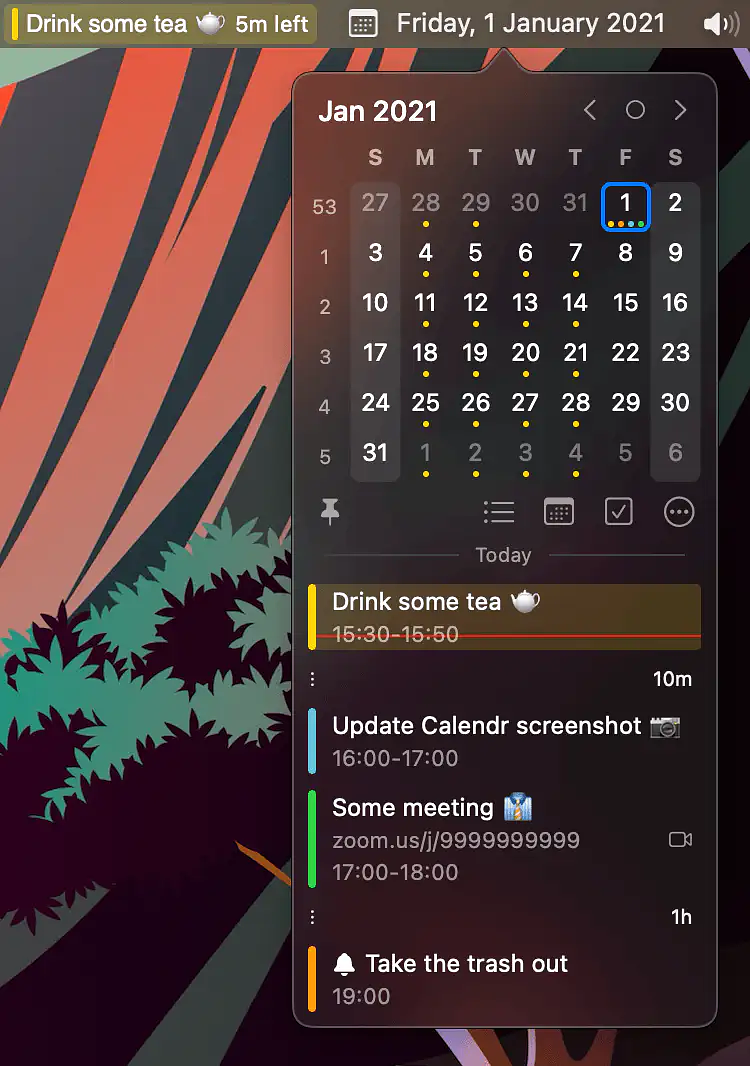DearMob iPhone Manager is a Useful Tool for Normies and Power Users

A few years back, I had an iPhone that just stopped backing up to iCloud. I went through every troubleshooter I could find, and nothing worked. At the time, I had a MacBook with a small hard drive (256 GB), and using Finder to back it up resulted in a file of over 90 GB, taking up a significant chunk of space. Not only that, it took about 30 minutes to complete. I had to hack together a way, using symlinks, to move the backup to an external drive. It was a huge PIA.
That's when I started using DearMob iPhone Manager. Its backup capabilities beat Apple's by a mile. You can choose your backup location. You still get encryption, and you can use Wi-Fi (which is slow but acceptable). It works all the way back to Mac OS X 10.9 but doesn't require Rosetta on Apple silicon.
I also recently used it to recover 80 GB of music from my dad's old iPod Classic with just a few clicks.
Useful Features
- Selective Control - Pull just the data off a phone that you want, in a usable format, without having to back up the whole phone. Very useful for specific groups of photos. You can transfer, backup, transcode, and restore photos easily.
- Wide File Type Support - Works with HEIC photos, RAW formats, 4K video, and more, and can do conversions on the fly.
- Speedy - Standard photo copies happen at the rate of 5,000 images a minute via a USB connection.
- Security - You can encrypt anything you export, including photo albums.
- Supports Cloning and Migration - Whether you're getting a new phone or doing a nuke and pave on your current model, DearMob has you covered with more flexibility than what Apple offers.
- Two Way Management - Supports messages, contacts, podcasts, files, apps, books, calendars, and more. You can add apps that are no longer in the App Store without jailbreaking your phone. You can also use your phone as a mountable drive for times when you need to Sneaker Net files around.
Pain Point
The main drawback with an app like DearMob is that you are always at Apple's mercy, and future changes to iOS and macOS may affect functionality.
The Good News
A lifetime license normally goes for $39.95, which lets you install it on one Mac and use it with unlimited phones. It's currently on sale for just $3 at Bundlehunt. At that price, it's hard to resist. Its main competitor is iMazing, which is subscription only ($49.95 a year) and limits the number of devices you can use.
Collections Database Hits a Sweet Spot

Collections Database is a user-friendly app by developer Matteo D'Ignazio, with an easy learning curve. It's not made for SQL experts or those who need complicated relational connections. For most Mac users who want a polished and well-supported way to manage and track collections, inventories, and various items, it's almost a no-brainer, supporting macOS and iOS and costing only $6.99 on the Mac App Store for the pro version. There is a free version, limited to 100 records, but sufficient for testing if you want to try before you buy.
What's To Like
- Ease of Use: Made for everyday use without requiring prior database experience or SQL skills.
- Flexibility: Over 20 different field types. Easy to customize and adapt for books, media, gear, inventory, etc.
- Templates: No need to start from scratch for common database types.
- Apple Shortcut Support: Easy to automate.
- Privacy: No ads and no login required. Data syncs via iCloud.
- Price: Compared to FileMaker Pro, which is a whopping $45 a month.
- Visual Features: The ability to use barcodes/images makes it more appealing than just a plain text app. You can add book jackets, movie posters, etc.
Caveats
- Not an enterprise app for those who need a full relational database with SQL support.
- The free tier is suitable for small collections and testing only.
- Moving single records between collections is kind of janky and not well supported.
- For UI/UX nerds, it can feel like an iPad port because some features don't have a native macOS feel.
- While it does have advanced features like formulas and linking, the documentation could be better, and the learning curve is a little steep in these areas.
- Performance can degrade with large collections (thousands of items) if there are many images and files attached.
I have Collections databases for quotes, specific groups of movies, and tech purchases. I've also found downloadable ready-made databases shared by other users. The developer, Matteo D'Ignazio, has a great reputation for being helpful and supportive, always a plus.
Keyboard Maestro is 50% Off for One Week at Bundlehunt!

The folks at Bundlehunt have managed to get the developer of Keyboard Maestro to offer the app at half price for seven days only.
Keyboard Maestro by Stairways Software is the preeminent automation application for macOS. It acts on nearly 30 triggers to perform almost any Mac function you can think of. It can launch tasks, control applications and manipulate text and images. It's easier to demonstrate its powers than to explain them, so I'll share my top 10 macros.
1. Add Today's Task
This is an example of a macro that runs an iOS shortcut, in this case one that adds my most important task of the day to my Obsidian daily note. I launch it with a keyboard shortcut.
2. Sync Obsidian Vault
This macro uses a time of day trigger to launch Sync Folders Pro every morning at 2am. That application then runs an automated sync of my Obsidian vault to my Google Drive folder where it gets uploaded automatically into the cloud. Keyboard Maestro shuts the program down five minutes later.
3. Create Daily Checklist in Drafts and Copy to Things 3
Every evening I trigger a macro from my menubar to use a template in Drafts to create my daily checklist in Things 3, complete with the due date, tags and areas. Mike Burke wrote a great piece on how to create the template for Things in Drafts.
4. Eject Backup
My daily driver at home is a M2 MacBook Air. Every night before I go to ned, I plug in a backup drive so that Time Machine can do its thing while I sleep. Every morning, 30 minutes before my alarm goes off, a time of day trigger causes a macro to execute that runs an AppleScript to eject the drive, so that when I start work in the morning, all I have to do is physically disconnect it.
5. Morning Apps
Every morning, right before I wake up, Keyboard Maestro launches my browser, Obsidian, Fantastical and the Photos app. That way I'm ready to start my daily note, keep up with my appointments and post a picture to Pixelfed, a daily habit.
6. Various App Launching Hotkeys
I use a hyperkey (CAPS LOCK) mapped as shift+control+option+command with Karabiner-Elements in combination with a hotkey to launch a variety of my most used apps, Edge, Drafts, Things, Bartender, Path Finder etc. All of that runs through small Keyboard Maestro macros.
7. Quit All Applications
At the end of a work session on my computer, I hit control+shift+Q and it quits all my open apps. That way everything can back up properly and I don't have to worry about open files.
8. Uninstall Apps
When I launch App Cleaner, it serves as a macro that arranges the windows on my computer automatically so that App cleaner takes up the right of the display and Path Finder, opened to the Applications folder, takes up the left half. Then it's just a matter of dragging over the app I want to remove.
9. Hide on Unlock
For privacy reasons, unlocking my computer triggers an Apple Script that hides all open applications. That way I don't have to remember what's on my screen nor do I have to worry about any prying eyes from nosy neighbors.
10. Window Management
I have mapped control-shift and the arrow keys to control window positions for top, bottom, left and right. I get more granular control using Raycast but for most cases Keyboard Maestro does just fine.
If you've ever considered getting this app, now is the time. Keyboard Maestro at Bundlehunt.
I have a collection of 800 macros on Github you can download and use.
Spokenly Free Version is My Voice-to-Text Daily Driver

My voice-to-text use case is almost exclusively dictation (in
English) in lieu of typing. There are a lot of transcription apps, many
of them very powerful with advanced features for enterprise and academic
users in multilingual environments. I don't need that. I just need
something dependable and free that works well and saves me from having
to type so much. After trying a great many apps, I'm most satisfied with
Spokenly.
Key Features for This Use Case
- Requires no account - just download it from the Mac App Store, set it up, and start using it. You don't need a username and password for functionality.
-
Local only, if you want - If you are privacy-focused, you can download and employ local conversion engines, including Nvidia's Parakeet, even on Intel Macs. I use it regularly on a 2019 MBP. Other local models include:
- Various Whisper implementations
- Parakeet version for multilingual use
- Apple speech analyzer for macOS 26
- Bring your own API key for online use - If you want to use your own API key for OpenAI, Soniox, Grok, or other specialized engines, you can do this and still stay with the free version.
- True universal compatibility - You can dictate text anywhere on the system where you can put a cursor, so Spokenly can fill in forms in your browser, compose emails and messages, and write Reddit posts or blog entries.
- Text replacement - You can set up custom replacements for anything you use regularly that your dictation engine chokes on: proper names, tech terms, place names/addresses, etc.
Other features
-
Agentic Control - If you want to get into setting up workflows that you trigger with your voice, Spokenly has a list of functions that it can automate:
- Search Google & YouTube
- Query ChatGPT & Claude
- Open/Close Apps
- Send keystrokes
- Open websites
- Run Apple shortcuts
- Run shell commands
- Supports 100 Languages - I am a native English speaker, but I have rudimentary Spanish skills (thanks to training with the Puerto Rican National Guard when I was in the Army). I can easily include Spanish phrases while dictating in English, and Spokenly changes gears on the fly.
- File Upload - You can upload recorded files and have them transcribed. This is a feature in other apps, and I suggest testing this out if it's something important to you. Uploading a two-minute voice memo you recorded in quiet conditions on your iPhone is going to work differently than a one-hour Teams meeting with 10 different speakers. YMMV.
Caveats
This is not a plug-and-play app for absolute beginners. You have to choose what model you want to use, and they aren't all the same. Luckily, Spokenly does offer some suggestions. If you go with a local model, you have to download it, and if you're short on hard drive space, the models are about .5 GB on average. If you want advanced online support, you'll need to obtain your own API keys or be prepared to pay for the pro version ($7.99 a month). Also, depending on your configuration, you may experience lag if you're on an older or under-powered device.
Stay is a Free and Useful Utility for Multiple Monitor Setups

When it comes to multi-monitor setups, users have wildly different
demands. Some people make extensive use of spaces, while others won't;
their applications must be tiled the exact same way at all times. My
personal use case in the two-monitor setup that I use is that I want
apps to open on the same monitor with each use. Although Stay does
remember tiled window positions in its profiles, I don't care so much
about that, because I tend to use most of my apps in full-screen mode. I
absolutely do not want to have to drag windows around from monitor to
monitor so that my muscle memory can take over as I work.
Free Solution
To accomplish this task, I use the free utility Stay from Cordless Dog Software. The core idea is that Stay lets me snapshot window positions (size + location + display) for particular configurations (e.g., laptop display only, laptop + external monitor) and then restore them when my display setup changes. It's not so much a fully featured window management tool as it is a "put my windows where I left them" solution across display changes and reboots.
Stay is free, and it supports Apple Silicon. It does not need Rosetta.
It isn't perfect or bulletproof. Apple Spaces are flaky, and anyone who says they aren't hasn't made extensive use of them. Stay can sometimes get confused, placing a window sized correctly in the correct position on your monitor, but in the wrong space. Apps that use non-standard windows (Steam, X11, Adobe Creative Cloud) don't always work well with Stay. Stay works best with a static setup. If you often open and close various windows and want tiling, automation, and snapping, Stay is not the product for you.
Caveat
Now, the biggest drawback for some people is that Stay appears to be abandonware. It's abandonware that works, so I'm fine with it, but some people won't invest 30 seconds of setup time in an app that hasn't been updated since 2021.
Paid Alternative
If you want a top-shelf, well-maintained app to do what Stay does (plus a lot more), my recommendation is Moom from the great team at Many Tricks Software. It’s more refined than Stay, featuring window-snapping and custom grid resizing. You can save and recall layouts, but it’s less strict about returning windows to exact positions when changing monitors.
There is also a new player in the space, Snaps of Apps, which I have not personally tried yet.
ExtraDock Simplifies Remote Work

On my workstation, where I get most of my work done, I have a dual
monitor setup dialed in over a period of time to match my preferences
for the apps and processes that I use daily. I am partial to a
keyboard-centric workflow. I have used keyboard-driven launchers for
many years, including LaunchBar
and currently Raycast.
However, I deal with a great many files, primarily photographs, videos,
music, and eBooks, moving them from different locations in my file
system to other locations. This requires me to use a mouse and to do
quite a bit of application switching. When I am away from home, whether
at a coffee shop or on an extended trip, I prefer to remote into my
primary workstation to get things done rather than use the native
interface on the MacBook Air I carry with me. This can be problematic
because, rather than having two 27-inch monitors, I'm limited to one
15-inch Retina display. I've tried a variety of remote access
applications, but right now, what works best for me is native screen
sharing through a Tailscale network.
I am constantly switching not only between applications but also between monitors. For various reasons, using the native Mac dock is not always practical because of screen space and window placement. Likewise, using a keyboard-driven launcher is also difficult, and the same goes for application switchers. Depending on the last thing you clicked on, you may activate an app on the remote machine, or you may activate something on your local machine. It can be a coin toss.
I've started using ExtraDock from Appitstudio as a way to simplify application access and switching when working remotely. I had been switching and launching apps with Start from Innovative Bytes, a menu bar app, but it takes too many fine motor skills to access the menu bar on a shrunk-down remote display for my liking. ExtraDock lets me create a variety of dock-like launchers for different workflows and activate one or more of them when needed.
Features I Like
- Different docks for different displays without interfering with the native dock
- Custom-sized dock icons
- Custom dock orientation (horizontal or vertical)
- Autohide or always on top choice
- Widgets in the dock (Finder, Time, Trash are the ones I use)
- Appearance customization for colors, borders, and spacing
Using ExtraDock in conjunction with Stay from Cordless Dog, an app that lets me configure apps to launch to assigned positions on different monitors, has been a real game changer. Getting to the apps I need when I need them while working remotely is no longer aggravating.
A lifetime license for ExtraDock is available for €31.99, or if you prefer, a one year subscription €9.99 . Both options have a 14-day money back guarantee.
tinyMediaManager - Power User Toolbox for Movie and TV Show Collections
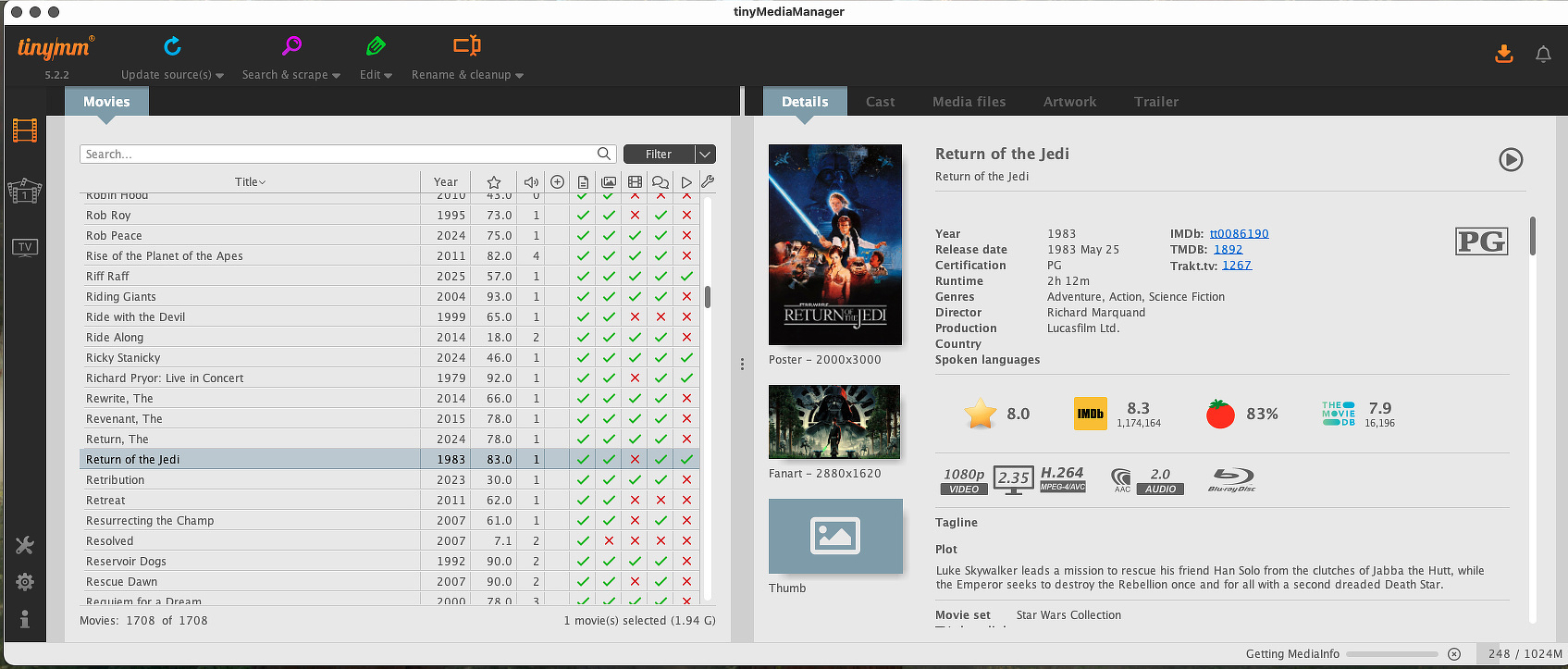
My personal media collection dates back to the days of ripping
Netflix DVDs, back when the Internet used to come in the mail.
Consisting of thousands of titles and weighing in at 20 TB, it presents
some management challenges. Keeping things organized and standardized is
important to me, and while I value automation, I also want full control
over my files. To that end, I use tinyMediaManager (aka TMM),
a cross-platform (macOS, Windows, Linux) app written in Java. Since it
is optimized for Apple Silicon, I use it on my M2 MBA rather than my
vintage Intel MBP. The actual files are located on my self-hosted server
and on a USB drive I use for archival purposes. Not having to keep the
files on a local drive is a big plus.
What It Does
It scans directories of movies and TV shows to scrape metadata from multiple sources (IMDB, TVDB, Trakt, etc.) to include:
- Trailers
- Subtitles
- Posters and artwork
It allows you to tag and organize your media into sets and collections. It generates NFO files used by the media-playing app Kodi (XBMC). It has powerful renaming tools, but be careful when using them, as there is no undo button. Test on a subset of files before going hog wild on your whole collection, and remember that backups are your friend.
Where It Shines
- Flexible metadata scraping: If you are really into maintaining a well-managed collection and have a subscription to Trakt Pro or similar services, TMM works well with them (and free sources) to retrieve rich metadata (cast, awards, artwork, subtitles, etc.).
- File/folder renaming & NFO generation: If you ever change your primary media player and need to reformat your metadata to use a new standard for Kodi (XBMC), TMM has got you covered.
- Large-library support and bulk operations: There are lots of folks with media collections that dwarf mine, and based on feedback I have seen in forums, TMM doesn't choke, although it can be slow to start up with large collections.
- Cross-platform and Apple Silicon support: On macOS, it has a dedicated ARM build (v5), so the tool is kept up to date with newer Macs, but if you're still on an Intel machine, it is supported.
- Highly configurable: You can rename tokens, adjust scrape settings, set file naming schemes, filter and sort large collections, and integrate with external tools like FFmpeg and yt-dlp.
- Good community feedback for power users: Reddit is the best resource r/TinyMediaManager.
Where It Doesn't Shine
- Look and feel: Because it's a cross-platform Java app, it doesn't follow typical macOS design standards. While it isn't as jarring as the Calibre interface, people who are picky about UX/UI will be put off.
- Steep Learning Curve: Some of the basic features, such as scraping, are pretty straightforward, but advanced features like renaming tokens, filters, and naming schemes take time to set up.
- Subscription/licensing changes / free version limitations: The software used to be freeware. Currently, the free version is limited (in loaded objects/API calls), and the Pro version requires a license that costs 1 euro a month.
If you manage your media through the "arr" stack, you can still benefit from using TMM to download subtitles and obtain trailers. I use a combination of Plex with Infuse as a front end and Jellyfin and have never had an issue with my files attributable to TMM.
Calibre Keeps Getting Better
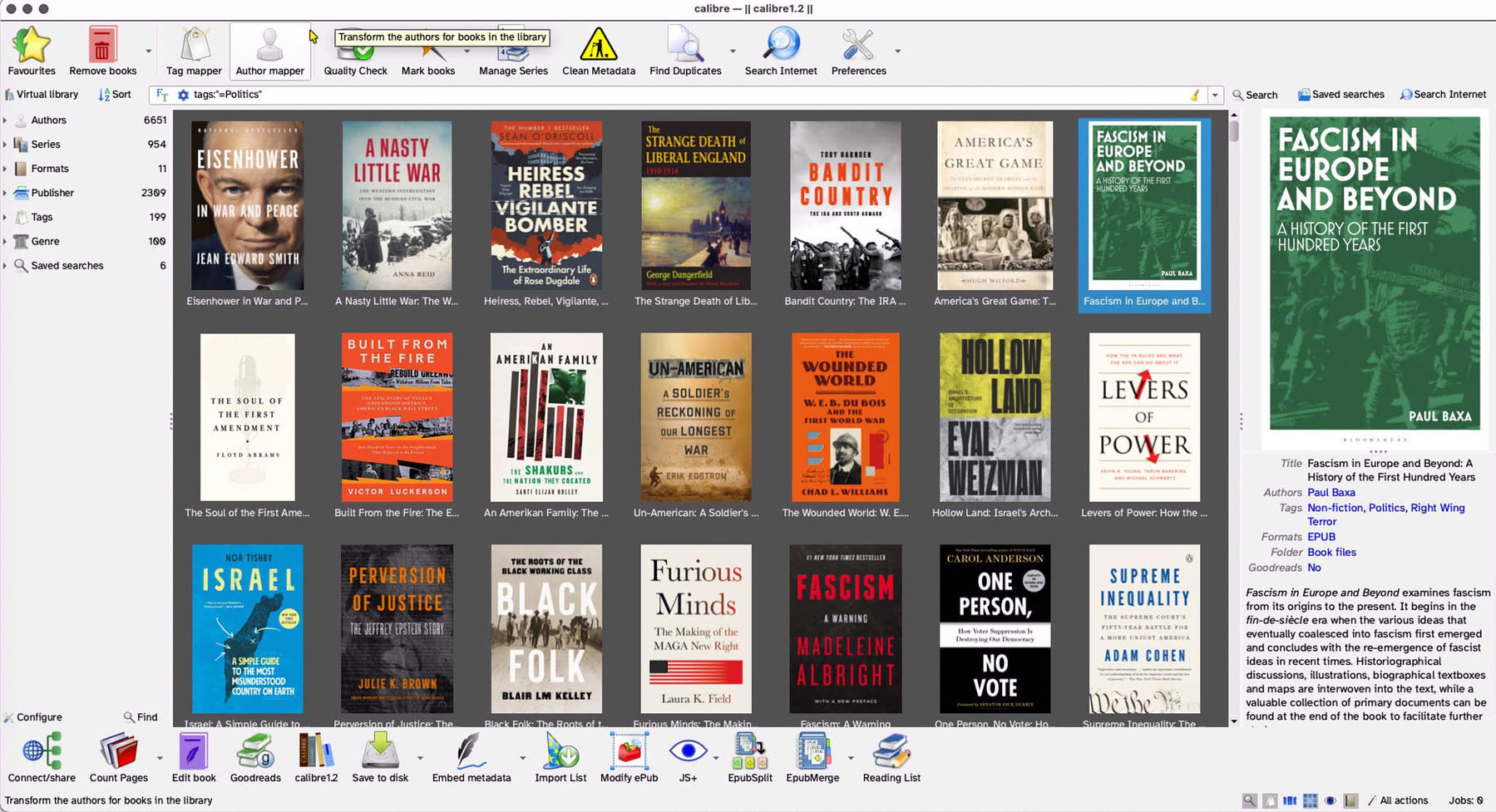
The free and open-source e-book manager, Calibre, by developer Kovid Goyal,
has been around for quite a few years now. It is multi-platform, with
versions for Windows, Linux, and macOS. It is somewhat homely, although
it includes functions to customize its appearance. It definitely does
not follow typical macOS interface standards, so if that's something you
require, you might have to compromise if you want access to Calibre's
features. However, for anyone with a moderate to large-sized collection
of e-books, it is a must-have toolbox, and after using it for a decade,
I am still finding new things it is capable of doing.
When you use Calibre to organize your collection of e-books, it can quickly show you all the books by the same author or in a book series or even books based around a specific set of topics if you take the time to tag your books when adding them to the app. It supports a huge number of formats (EPUB, MOBI, AZW3, PDF, TXT, CBZ/CBR comics, etc.) and has a built-in format converter if you want to standardize into something like ePub. The built-in viewer is perfectly fine for reading books on your computer. The Calibre database allows you to create your own fields with a list of data types that you can use. You can choose to display them or not, and organize your books accordingly. It's easy to dump your entire collection into a single logical organization but view different subsets as virtual libraries. You can group books by very specific criteria, such as books about baseball published in the 1990s with a four-star or above rating that you have already read and own a physical copy of.
Calibre has a robust collection of free plug-ins that are integrated with other services such as Goodreads, The Open Library, and Hardcover. You can tap into the review and book jacket databases of many different websites. If you are looking for a book that you do not own, you can search for it from within the Calibre interface using both free and paid websites. Calibre can perform many actions on individual books, such as page counts and determining reading levels. You can choose to have it index the contents of your entire collection of e-books, which will enable you to quickly perform full-text searches, a feature that can be invaluable when doing research. You can use Calibre to edit e-books and to join and split e-books, which is useful when you have an omnibus edition of a collection and you want to make individual files.
If you use an electronic reader of almost any type or vintage, you can use Calibre to add and remove content, especially file types that the native software doesn't handle well. If you want to read news articles and magazine articles on an e-reader, Calibre has built-in functionality to download and format them for you.
I keep my Calibre library in a couple of places: my always-on Mac and mirrored to my self-hosted server. I have local and remote access to it, allowing me to share books with other people via links and email and to read anything in my collection from a browser, no matter where I am.
Strengths
- Versatility
- Conversion
- Metadata and library management
- Device and content server support
- Open source and extensibility
- Frequent updates and new features
What Mac Users Don't Like
- Non-standard interface
- Poor handling of complex conversions (although to be fair, even expensive paid apps like Abby Fine Reader can struggle with these)
- Complexity and learning curve
- Limited support for older macOS versions - There are versions of Calibre that will work all the way back to OS X versions, but don't expect them to match the latest version feature for feature.
What's New
If you used Calibre in the past but haven't checked it out recently, here are a few of the latest feature additions:
- Native Kepub support for Kobo readers
- "Connect to folder" capability to treat remote folders as if they were USB storage devices
- Interface changes in the Mac version to meet some Mac design specs
- Improved opening speeds for large ePubs
- Light/Dark mode for the display grid using book covers
- Metadata merging (including comments) for books
- Bulk operations improvement, including the ability to cancel remaining actions in a large queue without losing the actions already performed on the queue.
People Sure Are Picky About PDF Tools

Few categories of software arouse as much debate as apps designed
to work with PDFs, primarily because there are such a variety of use
cases and work flows around these documents. As anyone who has ever
worked in IT support can tell you, every ignorant enterprise user that
has ever lived is convinced they need Adobe Acrobat Pro - to hell with
its huge footprint, huge cost and hefty learning curve. Even
knowledgable Mac users who are infrequent users of PDFS, remain in the
dark about all the powerful features available in the native macOS
Preview app:
- Annotate and mark-up Documents & Images: add highlights, underlines, shapes, text boxes, free-hand drawing, callouts, sticky notes.
- Fill out PDF forms / add signatures: you can type into form fields (where detected) and insert an electronic signature via trackpad or camera.
- Rearrange, delete, insert pages in PDFs: drag pages in the sidebar, drop in images or other PDFs, merge documents.
- Redact or permanently hide sensitive content in PDFs/images: Black-out (redact) areas so they cannot be recovered.
- Export/convert file formats: e.g., change image formats, export PDFs with encryption/passwords, save in various file types.
- Built-in OCR/text selection on images (in supported cases): lets you hover/select text in an image and copy it.
- Password protect & set permissions in PDFs when exporting: you can lock a document so it can’t be printed/copied/edited.
Users who have easily defendable specific needs for powerful PDF apps include those in academia, the legal profession and finance, where there are often laws concerning data retention for the massive amounts of data generated. And, of course there are lots of one off cases for different roles that can be incredibly specific.
For many users, occasional PDF needs can be easily met by free online tools that do document conversion, signatures and advanced annotation:
- iLovePDF | Online PDF tools for PDF lovers
- Smallpdf.com - A Free Solution to all your PDF Problems
- Best PDF Editor | Edit, Sign, Merge & Secure
For my advanced needs, which are primarily the conversion of large PDFs into ePub and other formats along with adding OCR to PDFS that don't have it, I am partial to Abby Fine Reader, which is a hefty $70 a year.
Currently, SwiftDoo PDF for Mac is on sale for $7.99, a considerable discount from the usual price of $98. At the discounted price, it's a decent bargain if your PDF needs fall in the these categories:
- Text/Image/Link editing – Unlike many simpler PDF viewers, you can edit text, change font/size/style, insert images, and embed hyperlinks. (Vendor version 2.0.0.3 added this explicitly.)
- Annotation tools – Highlights, underlines, strikethroughs, sticky notes, shapes, drawing freehand: useful when marking up documents rather than just reading.
- Page-/document-management – You can rotate, insert, delete pages, reorder, etc. Good for cleaning up multi-page PDFs.
- Security features – Password protection, permission settings (view/copy/print/edit) are included in the Mac version.
When compared to the Windows version of the app, the Mac version comes up short, primarily because it lacks OCR conversion and batch conversions. It's also not optimized for Apple Silicon, meaning it requires Rosetta which will not be supported after the current version of macOS. You can spend more money and get more features from other PDF suites like PDF Expert ($140 one−time)and Foxit PDF Editor ($130 - year).
Ping Uptime Monitor - Simple and Configurable

Ping Uptime Monitor by Neat Software is a
lightweight menubar app that monitors the availability and response time
of any entity with an IP address: websites, APIs, servers, routers,
devices and workstations. When problems are detected, it alerts you. It
has a limited free tier and a pro upgrade to unlock the full feature
set(one-time purchase, not subscription). You may be thinking that you
don't ned a tool to do your pinging, since that's a command line tool
that's among the first that many of us ever learned, but bear with me,
because Ping Uptime Monitor can de some useful stuff.
Features
- Heads up display via a color coded icon in the menu bar, allowing you to quickly assess the status of your website or API without keeping a browser tab open
- Local notifications when the status of a monitored address fails or exceeds a user-defined metric so that you are the first to know if an asset goes offline before its users can start complaining
- Supports HTTP and ICMP pinging so you can monitor your home router (ICMP) and a public website you want to track (HTTP)
- Supports IP4 and IP6
- Reportson slow response times, not just a binary up/down. You can determine at what speed you want to be notified so that you can mitigate anything running slow or dropping packets
- User defined ping intervals so that you don't flood some poor endpoint. You can set different intervals for different targets and the more important a device is, the more frequently you can check it
- Excellent logging capabilitythat can be piped or streamed out. Although you don't get a different log for every device, it is quite easy to filter the log so you can see exactly what you want to see
- Automation- Webhook capable so that it can use email, Slack or SMS to notify you when there are problems and you are AFK. It is also has AppleScript support
- Display customization so that you can select just want you want to see: icons, status colors, response times, etc.
- Privacy focused - nothing is routed through third-part devices. All communication is between your Mac and the endpoints you monitor.
- **CSV Imports **- got a spreadsheet with all the wireless access point IP addresses in your building? Import that sucker!
What's in the Newest Version (September 2025)
- Support for macOS26 Tahoe
- Auto-restores paid pro upgrades when moved to a new machine
- Auto-restart after 1 million pings to relieve any memory pressure and improve stability
This app is not for you if...
- You need advanced or per-device logging
- You want to create different groups of addresses to reflect different sites
- You need enterprise level features such as deep analytics, long-term trend reports and other features common in more expensive monitoring suites.
- You need an audible alarm (although this is a much requested feature)
Other Tools
This is a useful tool for small workplaces, home lab and power users. It compares to the FOSS app, nping. For broader use cases, check out Uptime Kuma. An online tool that you might useful is Uptimerobot
Availability
You can get the free and paid version ($14.99) of Ping Uptime Monitor from Neat Software. It's currently on sale for $3 for Black Friday - here.
PowerPhotos Supercharges and Complements What Apple Provides
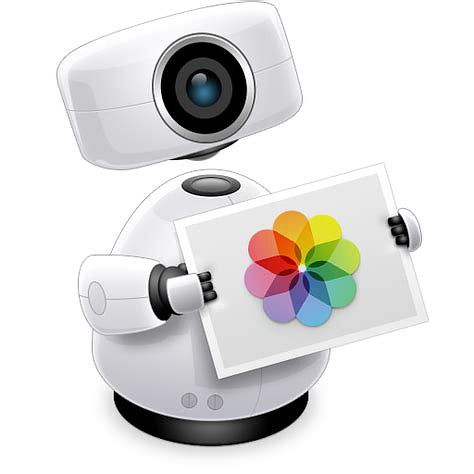
I've been taking iPhone photos since 2009, lots of them. I also
own and use a DSLR, and my hard drive is full of huge raw photos
stretching back to the last century. I've used a variety of photo
management apps through the years, but let's face it, for all its many
faults, Apple's native Photos app makes it super simple to create and
share images right out of the box. This makes it tempting to use, and
few people abandon it entirely, even if they also use something more
powerful.
PowerPhotos by Fatcat Software is a powerful tool that just about perfectly complements the native macOS app. It's got the features the native app is missing. It works in conjunction with Photos to handle the tasks Apple still doesn't handle well, if at all—splitting/merging libraries, finding real duplicates, bulk metadata edits, multi-library search, and moving or copying items across libraries without losing edits or keywords.
Key Strengths
- Multiple libraries Create, split, merge, browse, and search across multiple Photos libraries (including nice touches like merge reports and album preservation).
- Real duplicate control. It groups duplicates and lets you choose keepers with rule-based logic (by metadata, keywords, etc.) instead of Photos’ opaque auto-merge. You can just delete the photos or place them into albums first.
- Batch metadata editing Edit titles, keywords, captions, individually or in bulk with templating.
- Advanced multi-library search. Build nested AND/OR queries (file size, duration, dimensions—criteria Photos lacks), search one or many libraries, and save queries.
- Copy or move between libraries. Keeps edits and metadata; the current version (3.x) provided the move option. Previous versions were copy only.
Not Perfect
- Apple is still in control - Certain actions depend on Photos/app/macOS versions. Apple changes can impose limits or require upgrades.
- Learning Curve - This is a power user's app with multiple options and features, not a set-it-and-forget-it option. Making frequent effective backups, which you test and verify, is more important than I can stress. You could mess around and delete your library with this app not paying attention. It wouldn't be easy to do, and I don't think the app is inherently dangerous. It is just powerful.
- Paid Upgrades - Although Fatcat Software offers a 50% discount to upgrade to new major versions, it's still not free. I'm not saying it should be, but I know some of you prefer a true lifetime purchase.
- Scary Apple Warnings - Apple doesn't endorse any third-party apps to integrate with Photos, including this one. This is a well-established application used by thousands of people, but be sensible and make backups. Apple isn't going to help you if you use some other app and screw up your photos.
Latest Feature Additions
As of today, the last update to PowerPhotos was in October 2025. The last update added a "Copy To / Move To" option to the context menu, something that was previously only available in drag-and-drop operations that weren't always obvious. Recent bulk metadata editing and improvements to the in-app viewer make operations quicker and smoother than in previous versions.
PowerPhotos normally sells for $39.95 on the developer's website. Upgrades are 50% off.
For just the next two weeks, you can pick up a copy from Bundlehunt for just $5.99 as part of their Black Friday sale. Don't wait around, though, because it will be gone by mid-month.
Mountain Duck Version 5 Has New Features and It's on Sale
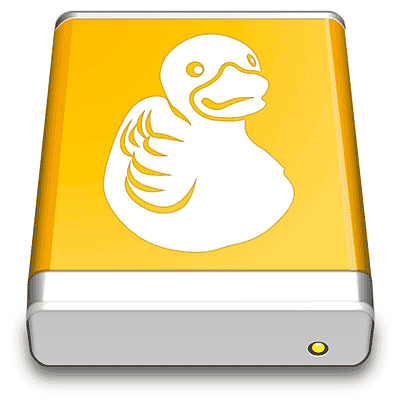
Mountain Duck is an app that allows you to integrate a variety of
remote storage providers directly into Finder without the need for other
proprietary software. This gives you the option to "open remote files
with any application," just as you can with the ones on your hard drive.
Some key features are:
- Multiple protocols supported: SMB, FTP, WebDAV, Amazon S3, Microsoft Azure, Google Drive, Dropbox, OneDrive, etc.
- "Smart Synchronization," where files remain remote until you open them; at which point, it opens and caches them. This can be complicated and a little tricky.
- Full Finder integration (via extensions) allowing context menu actions, link sharing, sync status, and more.
- Licensing - one license lets you use it on all the computers you own, but major upgrades are paid. Mountain Duck v. 5 is recent, so you should be good for a while if you purchase it now.
Strengths:
- Flexible - I used it to mount OneDrive, Dropbox, Box, two WebDAV providers, and a remote SMB share.
- Finder integration is consistent across providers, something you don't get by running the software from multiple providers.
- Background operations (smart sync/offline options).
- Actively maintained. The changelog shows frequent updates and bug fixes, which is typically the sign of a dependable developer.
Weaknesses:
- Predictably, mounts with lots of folders and files are not as responsive as those with fewer files and folders. I noticed this when working with my photo collection (100K+ files) on a remote WebDAV server.
- Working with cached files requires pretty careful monitoring. Not going to lie, setting up caching can be confusing, and it pays to keep your eye on what's going on.
- The lack of free updates for major versions.
- Working with multiple protocols and options (sync vs. online vs. offline vs. integrated vs. smart modes) presents a learning curve. If you just want to mount an S3 bucket and go about your business, this may not be the app for you.
New Features in Version 5
If you used Mountain Duck in the past (as I have), there are some cool new features in version 5:
- Now uses the native File Provider API, the same as iCloud and OneDrive.
- Supports Spotlight search.
- SMB support.
- Versioning (can be customized).
- Improved sync conflict handling.
- Activity monitoring.
- Resume pending operations (helps with big data workflows).
Mountain Duck normally sells for $49 on the dev's website. It's currently on sale for $14.99 as part of the Black Friday Bundlehunt offerings.
The New BundleHunt Mac Bundle Is Live — Here’s What’s Worth Grabbing
The bargain software shopping spree that happens every November leading up to Black Friday is officially underway. The new Bundlehunt offering debuts today with an unusually strong offering of power user tools as opposed to a collection of cookie-cutter clipboard managers and AI chat wrappers. It's got good automation tools, some real creative apps, and a few niche power-user picks that would normally run you $40 or more.
I've been buying apps from Bundlehunt since 2015. When you make a purchase from them, you get a personally generated page with download links, license codes and installation instructions. Some apps are for a single computer, but often you can install what you purchase on multiple Macs. You can also download a CSV with all that info for your records. Not every app is a gem of course, but it's been a great way for me to pick up some real keepers at a fraction of the normal price. Additionally, I have never had a security issue with anything purchased there if you are wondering "Is it safe?"
My usual disclaimer - I'm not affiliated with any of these developers. In most cases, I've listed alternative apps that provide similar functionality to what's on sale here.
The Bundle BundleHunt
Black Friday Bundle
Mountain Duck (💯 - Get This)

A file-system client that mounts remote servers and cloud storage as
local drives in Finder, providing direct file-level access without
syncing. Supports S3, WebDAV, SFTP, Azure, Google Cloud, and more.
Comparable tools: Transmit (mount feature), ExpanDrive MSRP
39–60 / Bundlehunt $14.99
PowerPhotos (💯 - Unique Feature Set)
Advanced Photos library management: merge/split libraries, detect and remove duplicates, search across libraries, and project migration assistance. Comparable tools: iPhoto Library Manager (legacy), Photos tools MSRP $30 / Bundlehunt $5.99
PowerPhotos - Merge Mac Photos libraries, find duplicate photos, and more
DearMob iPhone Manager (💯 - Comes in Handy)
Local device management utility for backup, media transfer, encryption, and device migration without relying solely on iCloud or Finder. Comparable tools: iMazing, AnyTrans MSRP 40–70 / Bundlehunt $3.00
OfficialDearMob iPhone Manager for iOS Data Transfer, Backup and Management
SwifDoo PDF
Full-function PDF suite offering editing, annotation, OCR, conversion, and signing with cross-platform licensing. Comparable.tools: PDF Expert, PDFElement MSRP 20–60 / Bundlehunt $7.99
PDF Editor and Reader for Mac - SwifDoo PDF
Mosaic Pro (💯 - Worth It!)
Advanced window management for macOS with custom keyboard shortcuts, snapping grids, automation, and multi-display support. Comparable.tools: BetterSnapTool, Magnet MSRP 30–40 / Bundlehunt $4.00
EaseUS NTFS for Mac (💯 - If you have the need!)

NTFS driver for macOS enabling full read/write access to Windows-formatted drives.
Comparable.tools: Paragon NTFS, Mounty MSRP 15–25 / Bundlehunt $6.00
NTFS for Mac|Read and Write NTFS Volumes on Mac - EaseUS
Yoink (💯 - Been Using this for Years)
A shelf utility that provides temporary storage for files, text, images, and clippings to streamline drag-and-drop operations across macOS. Comparable.tools: Dropzone, Paste MSRP 8–10 / Bundlehunt $1.99
Yoink for Mac - Simplify and Improve Drag and Drop
Spotless
Automated file organization based on user-defined rules for naming, sorting, moving, and tagging files. Includes scheduled cleanup features. Comparable tools: Hazel, A Better Finder Rename MSRP 10−20 / Bundlehunt $3.00
AWZ Screen Recorder
Screen recording utility supporting region and full-screen capture,
webcam overlay, and system/microphone audio recording.
Comparable
tools: ScreenFlow, Capto MSRP 25−40 /
Bundlehunt $5.99
AWZ Screen Recorder for Mac | Easy & Feature-Rich Screen Recorder
Super Vectorizer Pro
Raster-to-vector tracing tool for producing scalable vector graphics from photographs and artwork with adjustable edge detection and color reduction. Comparable tools: Vector Magic, Inkscape Trace MSRP $30 / Bundlehunt $6.00
Super Vectorizer - Image Vectorizer on Mac Win
Super PhotoCut Pro
Foreground extraction and background removal tool optimized for batch
product and portrait workflows.
Comparable tools: Pixelmator
Pro, Remove.bg MSRP $30 / Bundlehunt
$5.00
Ping Pro (💯 - Must Have)
Network diagnostics tool focused on continuous ping monitoring,
packet-loss tracking, and troubleshooting unstable connections.
Comparable tools: PingPlotter, iNet Network Scanner MSRP
5−15 / Bundlehunt $3.00
Ping • Network Uptime Monitor for macOS
MindArchitect Pro
Diagramming and mind-mapping software for structuring concepts,
brainstorming, and visual planning.
Comparable tools: MindNode,
XMind MSRP 30−50 / Bundlehunt
$4.00
RocketCake Pro
Visual website builder supporting responsive design, CSS editing, and
export-ready HTML without requiring coding.
Comparable tools:
RapidWeaver, Blocs MSRP 50−80 / Bundlehunt
$7.99
SurFast Video Downloader Pro
Video acquisition utility for saving online video streams locally in
multiple formats.
Comparable tools: Downie, VideoDuke MSRP
20−40 / Bundlehunt $5.00
SurFast Video Downloader for Mac - Download it from Uptodown for free
Almighty (💯 - Top Pick)

System customization and automation tool offering deep macOS behavior
tuning, quick toggles, and workflow shortcuts. .
Comparable tools:
One Switch, BetterTouchTool MSRP 20−30 /
Bundlehunt $3.50
Almighty - Powerful
configurations for Mac
ColorHound
Color picker and palette tool for identifying on-screen colors, saving swatches, and managing palettes. Comparable tools: Sip, ColorSlurp MSRP 5−8 / Bundlehunt $1.50
Color Hound | Image color palette generator for macOS
Watermarker+
Batch watermarking solution with text and image overlays for catalog
photography and brand asset protection.
Comparable tools:
PhotoBulk, uMark MSRP 15−30 / Bundlehunt
$2.00
Watermarker+ | Batch watermarker tool for macOS
DMG Wizard
Utility for creating customized DMG installers with compression and
branding options.
Comparable tools: DMG Canvas, DropDMG
MSRP 10−20 / Bundlehunt $1.50
DMG Wizard | DMG app packager for macOS
Textilicious
Lightweight text transformation utility offering formatting tools (case changes, cleansing, quick conversions) for clipboard or batch text operations. Comparable tools: TextSoap, BBEdit (scripts) MSRP 5−8 / Bundlehunt $2.50
Textilicious | Advanced Text Transformation Tool for Mac
Finder Windows
Tool for quickly navigating, switching, and managing open Finder windows
and workspaces.
Comparable tools: Commander One, Path Finder
MSRP 3−8 / Bundlehunt $2.00
Access macOS Finder windows easily | Finder Windows – Zevrix Solutions
Total Video Converter
Comprehensive format-conversion tool supporting a wide range of codecs,
batch conversion, and device-target presets.
Comparable tools:
Permute, HandBrake MSRP 30−40 / Bundlehunt
$5.00
Total Video Converter - Convert Any Video and Burn to DVD
MultiDock
Creates multiple customizable app docks to group workflows and reduce
clutter. Comparable tools: uBar, Station
MSRP
5−−15 / Bundlehunt $3.00
Tab Finder
Search utility for locating open browser tabs across windows to
streamline tab-heavy workflows.
Comparable tools: Tab Space,
Tab Manager extensions MSRP 5−10 / Bundlehunt
$2.50
Tab Finder | A list of all your open tabs across all browser windows in one place • MacPlus Software
One I Would Skip
Mail Archiver X
I've written a full
length review of this app. It didn't function as advertised and tech
support was a whopping $70 per incident at the time I evaluated the app.
Long-term email archiving and indexing software designed to preserve
searchable, offline access to mail across clients and accounts. Supports
IMAP, Apple Mail, Gmail, and Microsoft 365.
Comparable tools:
EagleFiler, MailSteward MSRP 50−60 /
Bundlehunt $6.99
How My Self-Hosted Server Fits My Mac Life

When I retired in February, one of the first things I did was set
up a home lab using the various components that I've been socking away
for years. For me, 2025 has been the year that I've left the tech giants
in my rearview mirror. To that end, I wanted to experiment with Linux,
even though I don't plan to abandon the Mac or iOS as platforms. After a
couple of months fooling around with Ubuntu on an old Lenovo ThinkPad, I
decided to build a self-hosted server using the same computer and a bevy
of external hard drives that I had accumulated.
I solicited advice on Mastodon and ended up going with Unraid, a NAS-based operating system based on Ubuntu. I know someone who has an Unraid server, and that played a part in my decision. Unraid is not free. I spent $49 for a license that allowed me to use six connected hard drives, and after three months, I upgraded the license so that I can use an unlimited amount of hard drives. Shortly after that, I ditched the old ThinkPad in favor of a new mini PC with USB 3.2 and a faster CPU. It was $150 for a machine with 16GB of RAM, a 512 GB HD, dual ethernet ports, 2 HDMI ports (although I run it headless) and four USB 3.2 ports. I oped to immediately replace the hard drive with a 2 TB model. Much to my surprise, the computer had space and a connection for a 2.5 inch SATA drive, so I threw in a 1 TB model I had laying around in there.
My external storage consists of three 8 TB drives (all purchased since I started self-hosting), a 1 TB and 4TB SSDs, a 3 TB drive left over from the days when I took a thousand shots a day on my DSLR and a lonely old 2 TB external drive that lived most of it's life as a Time Machine drive. My future plans involved larger drives, housed in four drive bays with USB 3.2 connectivity. I've become an expert in finding good deals on hard drives.
I didn't have to buy a new domain name for my server. I just use subdomains from one I already won. Cloudflare takes care of all the networking and routing under their generous free program. I set up a tunnel to my server and now adding access to a new self hosted dervice takes about two minutes to make live.
Another free service that's proven invaluable is Tailscale, which allows you to create a private mesh network, assigning an IP address to your devices in a way so that even your hundreds of miles away, you can still make connections and use resources as if your two devices were sitting on the same desk.
My Services
Immich - Since I removed my photos from Apple, Google and Amazon, I needed a way to share them with my family over the Internet. I also needed a system that my wife and I could use together. Immich is a powerful photo management solution with excellent facial recognition and object identification when searching and it all lives on your computer. I have back up copies of my photos on a cloud server from a European company. Koofr. Immich has iOS and Mac app, although the latter only works on Apple silicon.
Audiobookshelf - Although I am no longer contributing to the enrichment of Jeff Bezos, I do want to have access to the audiobooks I purchased from Audible. I used the free app, Libation to liberate my library. It downloads all your books and removes the DRM that prevents you from with Amazon's hand in your pocket. Now I have a self hosted audiobook library, complete with metadata where I can stream of download books. If I want to gives access to antone else, it's easy to create an account to give them access too. There are various iOS apps compatible with Audiobookshelf.
Calibre-Web - Although you can no longer download the books you've purchased for your Kindle, if you have copies you saved befor April, 2025, you can strip the DRM from them tooand make your whole library available to you from any Internet connected reading device from your own server, wherever you are. You can use the Mac or iOS version of Calibre, or you can import books into the Mac and iOS program.
Plex - If you've obtained movies and TV shows from various sources (no judgement zone), you can create a media server on your computer than you can access from your SmartTV, streaming device, iPad or computer. You don't even have to be at home. If you want to give access to those resources to other people, you can do that as well. Plex works best when you buy the $40 a year Plex pass.Oh, and Plex also can display your photos and give you access to your music collection. If you still have all those ripped CDs and the spoils of the Napster days, you can ditch Apple Music and Spotify.
Copyparty - Although i still use (European based) cloud storgae, it serves primarily as an offsite backup. My day to day work is done on files that live on my self hosted server. Copyparty is an app that runs on my server and is accessible through any browser or file manager you can think of. It handle uploads and downloads, plays music and displays videos to boot.
The ARR Stack - For those sailing the high seas to obtain their media, there are self hosted apps like Radarr, Sonarr, Prowlarr, Huntarr and many more. The ARR stack automatically searches for titles you want, downloads them, adds metadata, subtitles and trailers and makes them available in Plex or Jellyfin. I'm so tired of contributing the the enrichment of billionaires, that after a more than 20-year absence, I have unashamedly returned to the seas myself. Arghhh!!
ProcessSpy
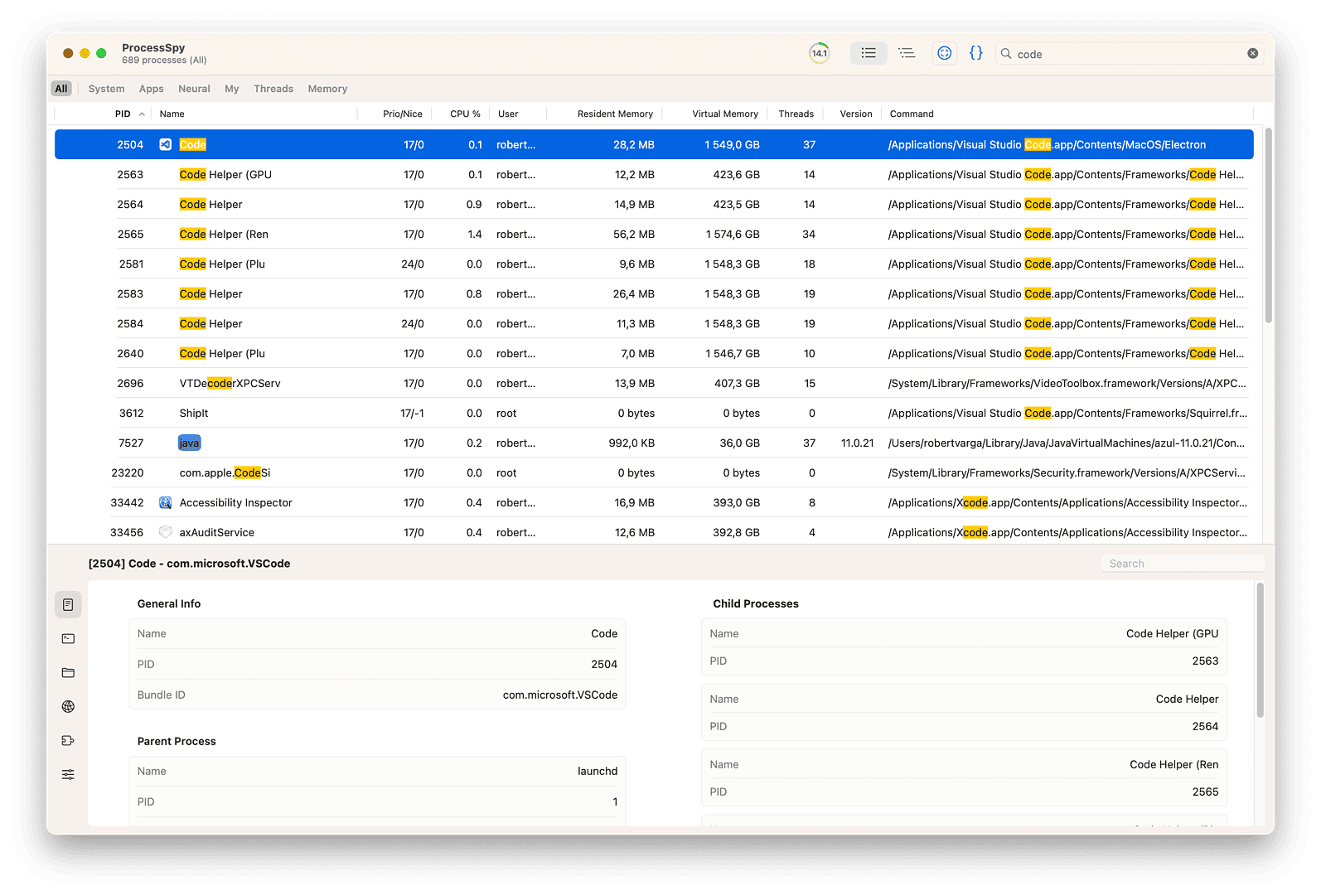
When troubleshooting system issues or thoroughly evaluating a piece of software, experienced and knowledgable Mac users often turn to activity monitor to get information on memory, CPU usage, power consumption and more. It's often helpful but at times it can be cryptic. The developer of Process Spy has an example. "I was juggling several Java apps, each using a different JDK version — and I couldn’t tell which process was which in Activity Monitor. All I saw was “java”. No version, no path, no details. So I built ProcessSpy — a developer-focused tool that shows full command-line info, version details, environment variables, and more."
ProcessSpy has quite a few free features and even more in the inexpensive ($6.99) paid version.
Features of ProcessSpy
- Advanced tree view - can show cumulative totals for CPU, Memory and Threads.
- Javascript filters - create complex filters with multiple conditions.
- Version information - shows the version information of the process right in the main table.
- Context menu actions - Show in Finder, copy path, search process online and more
- Advanced process info (paid) - view advanced information like entitlements, Info.plist, and bundle ID and more
- Environmental variables (paid) - view environment variables of the process.
ProcessSpy iis distributed as a signed app in a DMG or through Homebrew. It runs on Intel and Apple Silicon Macs using macOS 14 or higher. In the free version, there is a 10-second wait screen before the program loads. Buying a license gets rid of that and offers extra functionality as described above.
You can purchase a license for ProcessSpy on Gumroad.
To install with Homebrew
brew install --cask processspy
ProcessSpy
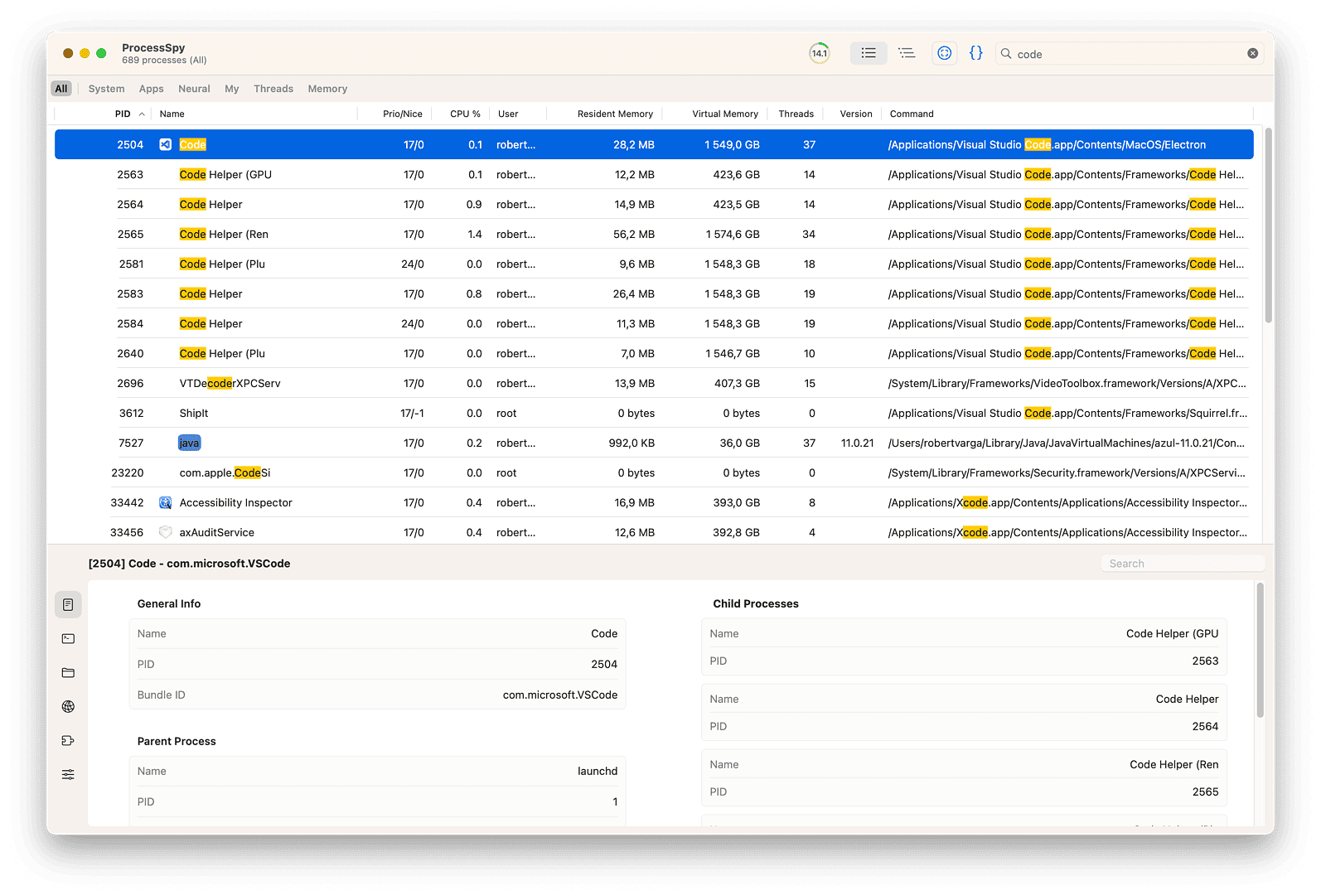
When troubleshooting system issues or thoroughly evaluating a piece of software, experienced and knowledgable Mac users often turn to activity monitor to get information on memory, CPU usage, power consumption and more. It's often helpful but at times it can be cryptic. The developer of Process Spy has an example. "I was juggling several Java apps, each using a different JDK version — and I couldn’t tell which process was which in Activity Monitor. All I saw was “java”. No version, no path, no details. So I built ProcessSpy — a developer-focused tool that shows full command-line info, version details, environment variables, and more."
ProcessSpy has quite a few free features and even more in the inexpensive ($6.99) paid version.
Features of ProcessSpy
- Advanced tree view - can show cumulative totals for CPU, Memory and Threads.
- Javascript filters - create complex filters with multiple conditions.
- Version information - shows the version information of the process right in the main table.
- Context menu actions - Show in Finder, copy path, search process online and more
- Advanced process info (paid) - view advanced information like entitlements, Info.plist, and bundle ID and more
- Environmental variables (paid) - view environment variables of the process.
ProcessSpy iis distributed as a signed app in a DMG or through Homebrew. It runs on Intel and Apple Silicon Macs using macOS 14 or higher. In the free version, there is a 10-second wait screen before the program loads. Buying a license gets rid of that and offers extra functionality as described above.
You can purchase a license for ProcessSpy on Gumroad.
To install with Homebrew
brew install --cask processspy
MountMate - A Tool I Didn't Know I Needed

I have an "always on" Mac on my desk with several external drives
connected to it, drives I need frequently, but not continuously. I'd
been putting up with a cluttered Finder and needless spin-ups for months
when I discovered MountMate this week. MountMate is a menu bar app that
mounts and unmounts external drives. Without MountMate, after a drive is
ejected, I'd have to go into Disk Utility to mount it back, or more
likely I'd just unplug and replug the drive, not a small task on a desk
with three computers and eight external drives. Some people use shell
scripts and other fancy methods to accomplish this, but that's a notch
above my comfort level.
With MountMate, those days are over. When I need to add or access files on one of my drives, I can do so with just a couple of clicks. MountMate has a lot going for it. It's a native app, not electron, and it has no dependencies. It doesn't require Internet access or root permissions and it doesn't access your files. It even has a bonus feature - reporting used/free space.
The developer, Homielab, is very responsive. The original release of MountMate didn't have Intel support, and he added it in just a couple of days when I requested it. He's also working on a solution that will display the authentication prompt in MountMate when encrypted drives (e.g., Time Machine) are mounted.
MountMate can be downloaded from the HomieLabs website or GitHub. It's free/donationware.
MountMate - A Tool I Didn't Know I Needed
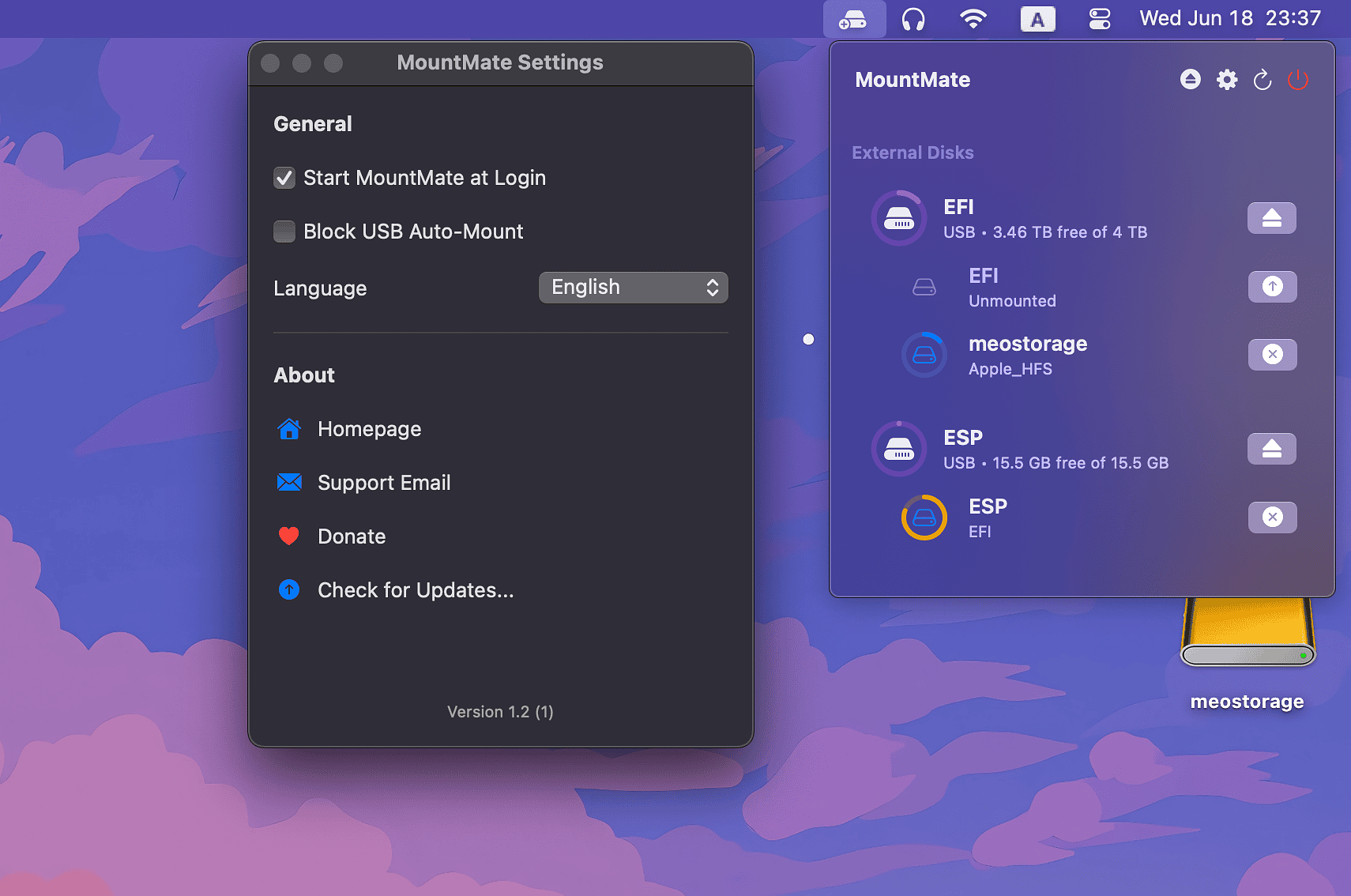
I have an "always on" Mac on my desk with several external drives
connected to it, drives I need frequently, but not continuously. I'd
been putting up with a cluttered Finder and needless spin-ups for months
when I discovered MountMate this week. MountMate is a menu bar app that
mounts and unmounts external drives. Without MountMate, after a drive is
ejected, I'd have to go into Disk Utility to mount it back, or more
likely I'd just unplug and replug the drive, not a small task on a desk
with three computers and eight external drives. Some people use shell
scripts and other fancy methods to accomplish this, but that's a notch
above my comfort level.
With MountMate, those days are over. When I need to add or access files on one of my drives, I can do so with just a couple of clicks. MountMate has a lot going for it. It's a native app, not electron, and it has no dependencies. It doesn't require Internet access or root permissions and it doesn't access your files. It even has a bonus feature - reporting used/free space.
The developer, Homielab, is very responsive. The original release of MountMate didn't have Intel support, and he added it in just a couple of days when I requested it. He's also working on a solution that will display the authentication prompt in MountMate when encrypted drives (e.g., Time Machine) are mounted.
MountMate can be downloaded from the HomieLabs website or GitHub. It's free/donationware.
Five Recent Finds at MacMenuBar
MacMenuBar.com is the best place on the Internet to find apps with that particular interface. Its recently added section is always worth checking out for new free, freemium and paid apps. Here are five recently added apps that are worth checking out.
Always on Top
Always on Top lets
you choose any window on your Mac to pin above all other windows. It's
got a nice menu-driven interface and is a nice addition to your
multi-tasking routine. (Free)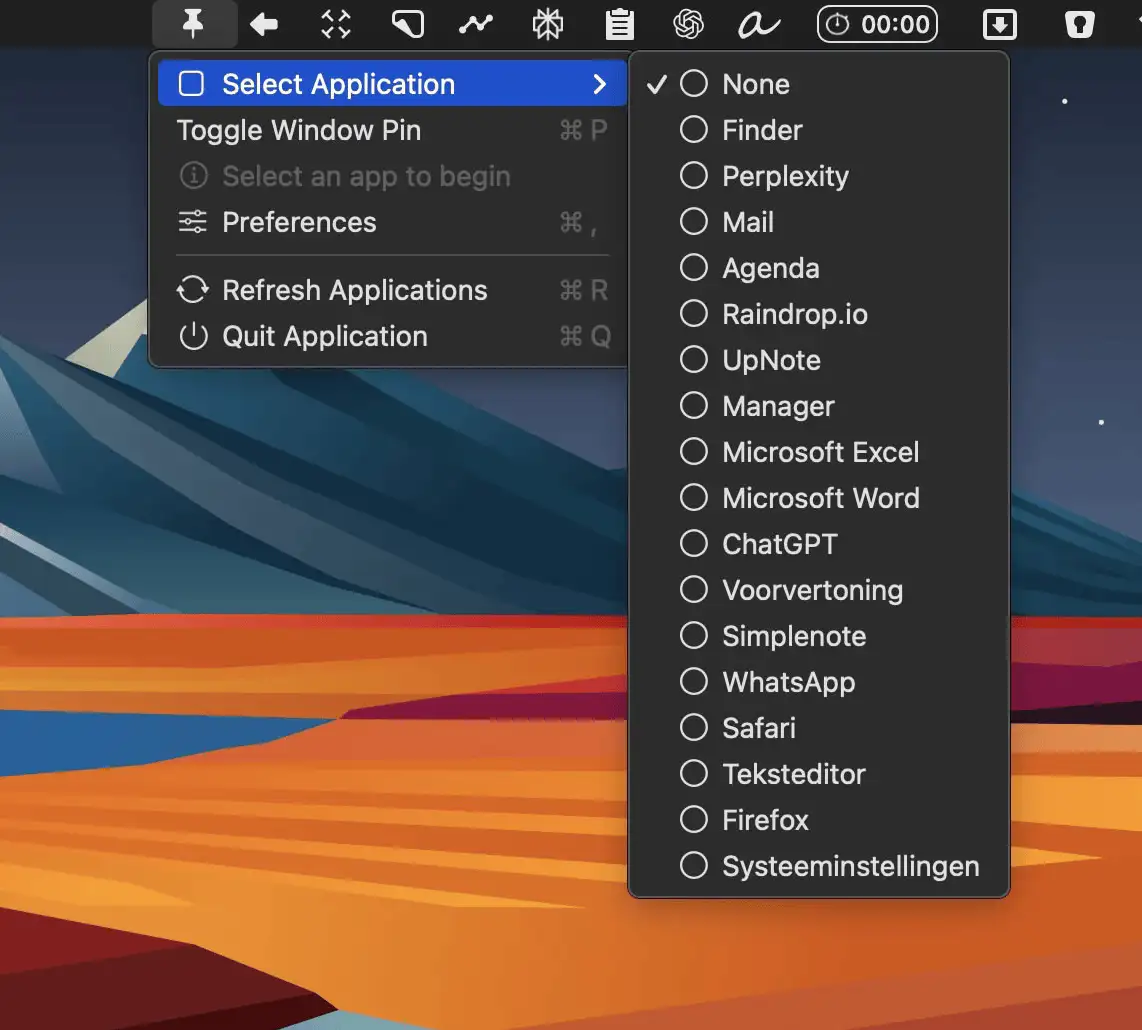
Signal Shifter
Signal Shifter
gives you a convenient location to control the inputs, outputs,
Bluetooth devices and volume control right from your Menu Bar.
(Free)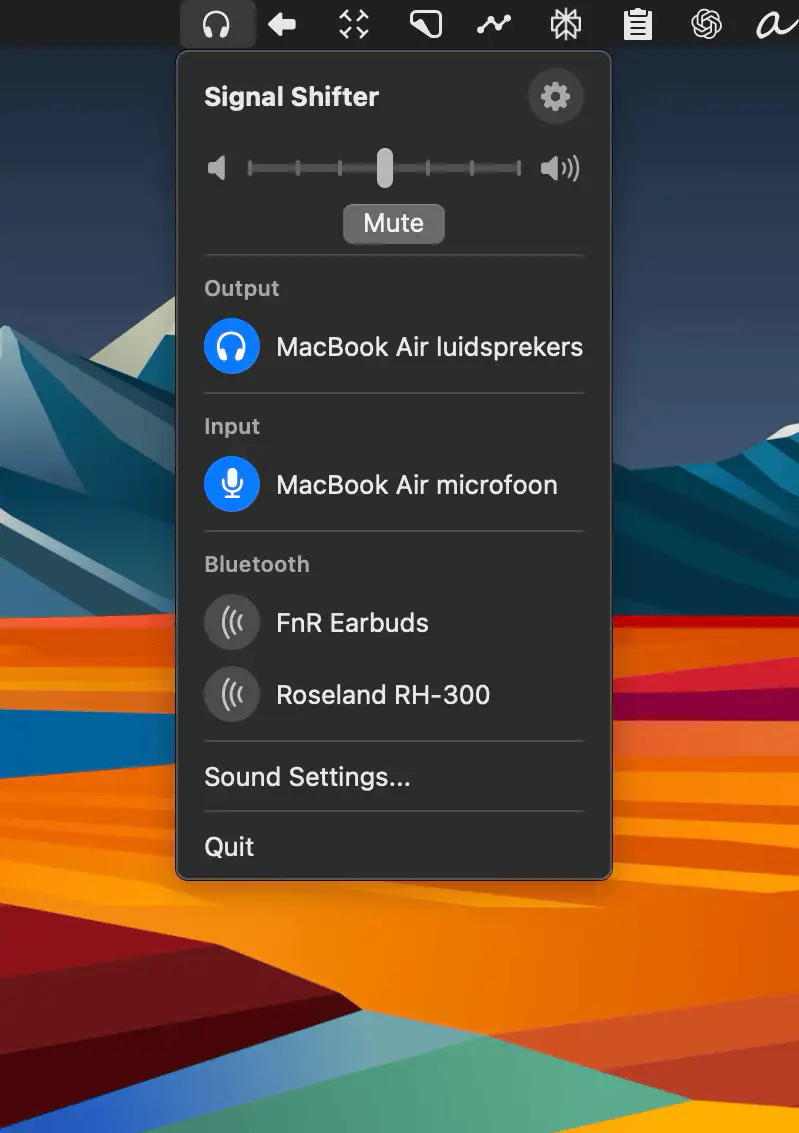
QuickGif
QuickGif provides a searchable Gif menu for use in any app. Drop GIFs into Slack, iMessage, Discord, and more. Save your favorites. (freemuim)

AppLockr
Applockr allows you to password protect any app on your Mac to prevent it being opened by anyone who should not access it. it's better suited for apps like Apple Notes that have an internal database rather than apps that create separately accessible documents. You should also lock Terminal and Activity Monitor to prevent unauthorized users from using those apps to force quit AppLockr itself. (one time payment)

Calendr
Calendr provides quick calendar access from your menu bar, complete with reminders. it has 1600 stars on Github, so plenty of people find it useful.
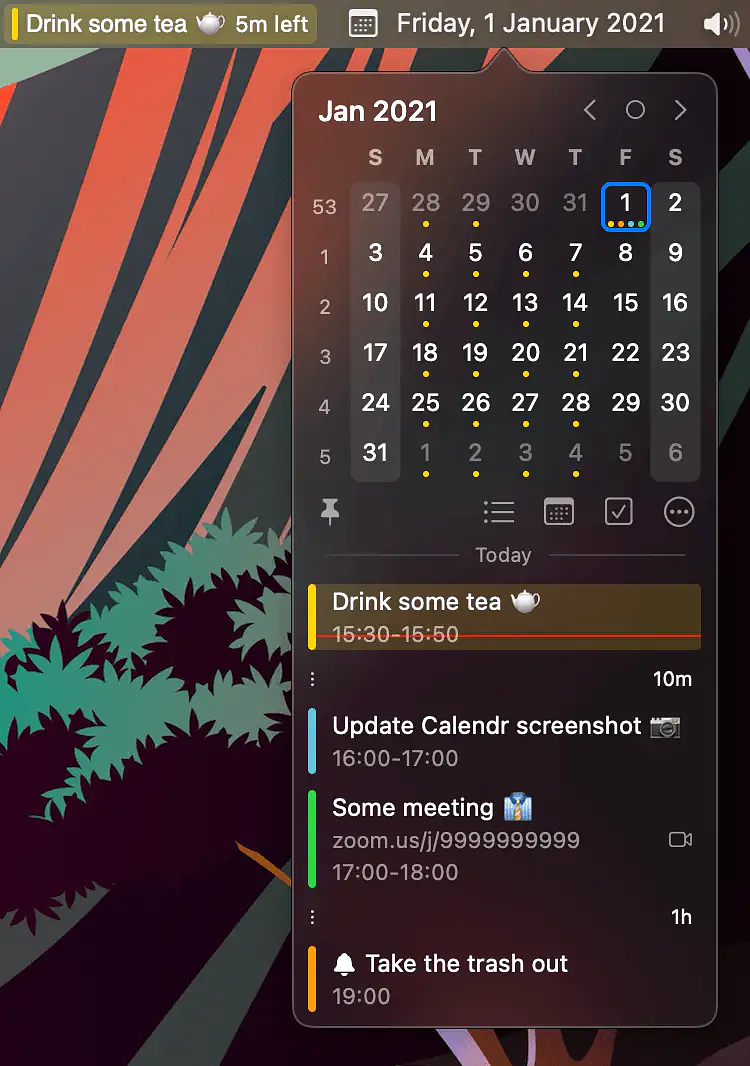
Five Recent Finds at MacMenuBar
MacMenuBar.com is the best place on the Internet to find apps with that particular interface. Its recently added section is always worth checking out for new free, freemium and paid apps. Here are five recently added apps that are worth checking out.
Always on Top
Always on Top lets
you choose any window on your Mac to pin above all other windows. It's
got a nice menu-driven interface and is a nice addition to your
multi-tasking routine. (Free)
Signal Shifter
Signal Shifter
gives you a convenient location to control the inputs, outputs,
Bluetooth devices and volume control right from your Menu Bar.
(Free)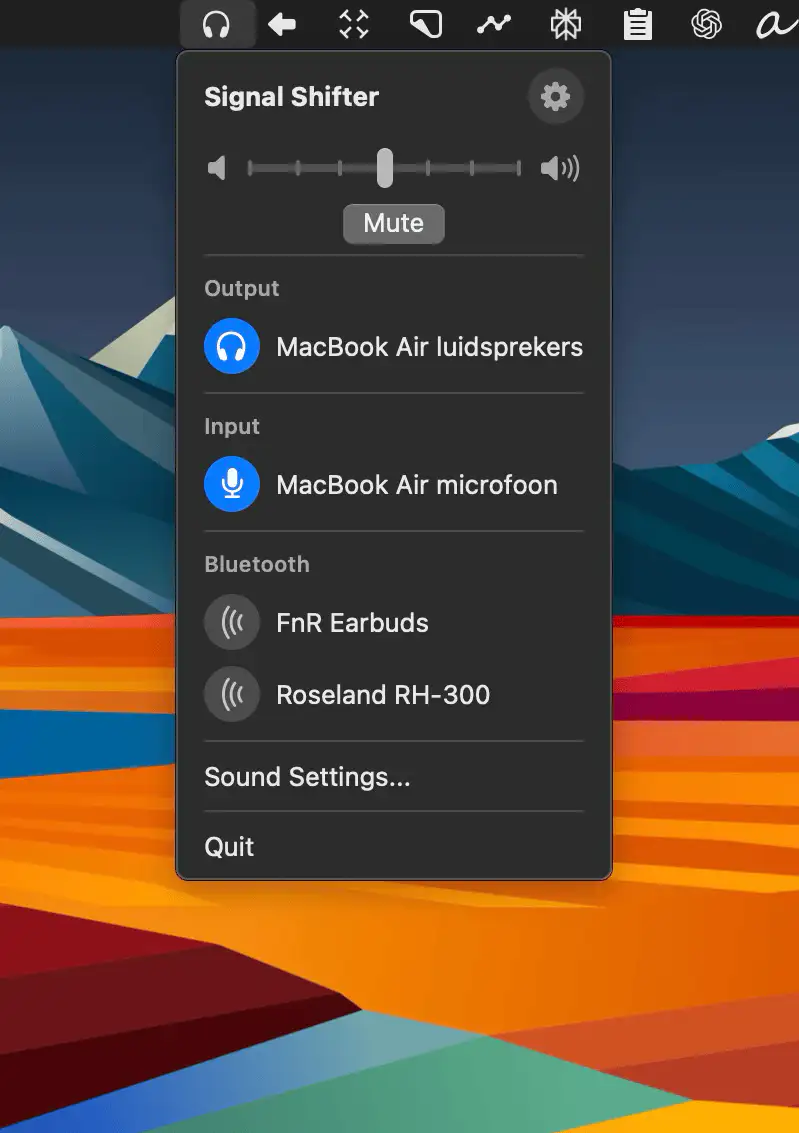
QuickGif
QuickGif provides a searchable Gif menu for use in any app. Drop GIFs into Slack, iMessage, Discord, and more. Save your favorites. (freemuim)

AppLockr
Applockr allows you to password protect any app on your Mac to prevent it being opened by anyone who should not access it. it's better suited for apps like Apple Notes that have an internal database rather than apps that create separately accessible documents. You should also lock Terminal and Activity Monitor to prevent unauthorized users from using those apps to force quit AppLockr itself. (one time payment)
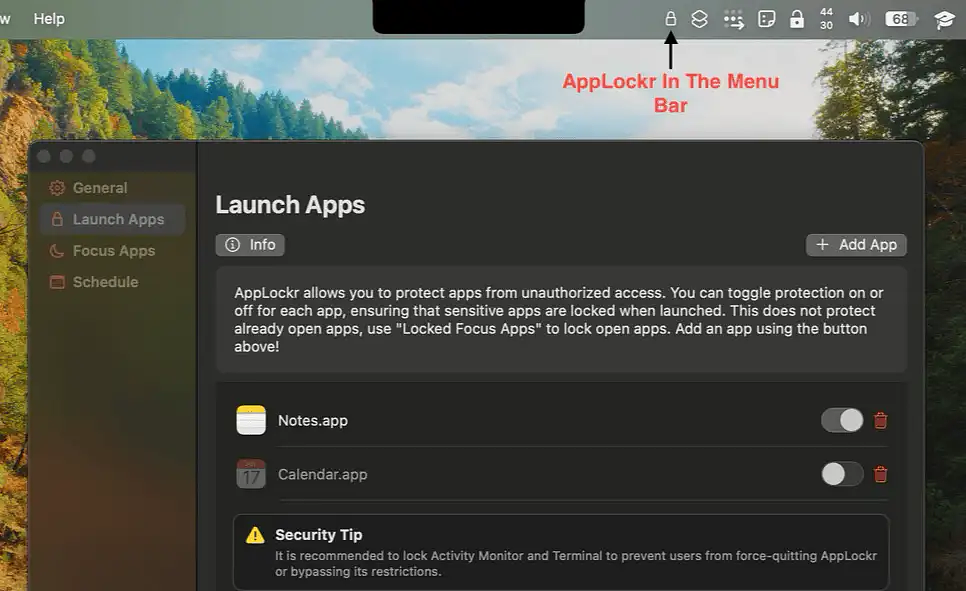
Calendr
Calendr provides quick calendar access from your menu bar, complete with reminders. it has 1600 stars on Github, so plenty of people find it useful.
